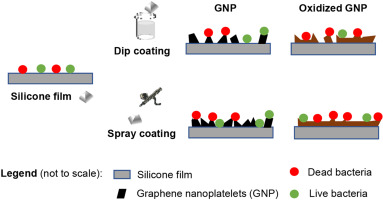Our official English website, www.x-mol.net, welcomes your feedback! (Note: you will need to create a separate account there.)
Antimicrobial graphene nanoplatelets coatings for silicone catheters
Carbon ( IF 10.9 ) Pub Date : 2018-11-01 , DOI: 10.1016/j.carbon.2018.06.044 Rita N. Gomes , Inês Borges , Andreia T. Pereira , André F. Maia , Manuel Pestana , Fernão D. Magalhães , Artur M. Pinto , Inês C. Gonçalves
Carbon ( IF 10.9 ) Pub Date : 2018-11-01 , DOI: 10.1016/j.carbon.2018.06.044 Rita N. Gomes , Inês Borges , Andreia T. Pereira , André F. Maia , Manuel Pestana , Fernão D. Magalhães , Artur M. Pinto , Inês C. Gonçalves

|
Abstract Silicone rubber (SR) peritoneal dialysis (PD) catheters are prone to bacterial adhesion and biofilm formation, which contributes to development of infection and associated morbidity in PD patients. We herein evaluate whether surface immobilization of graphene nanoplatelets (GNP) provides antimicrobial properties to SR. Dip and spray coating were used to deposit a dispersion containing SR and GNP-M5 or its oxidized form (GNP-M5ox) on the surface of silicone. The antimicrobial effect of GNP exposure and oxidation towards Staphylococcus epidermidis was assessed. GNP was successfully exposed on the surface, and while dipping provided better adhesion of either GNP, spraying resulted in uniform and higher surface coverage. Spraying led to enhanced bacterial adhesion comparing to dip coated and uncoated SR, which are similar. However, independently of the technique, GNP-M5ox coatings induced higher bacterial death. As such, SR/GNP-M5ox coating performed by dipping revealed to be the most promising approach, preserving bacterial adhesion levels of silicone while increasing bacterial death to around 80%. For the first time, graphene-based materials antimicrobial activity was evaluated by quantification of bacterial adhesion and viability. The high antibacterial effect, associated with a stable and cytocompatible coating which does not delaminate from SR surface, demonstrates its potential use in silicone biomedical industry.
中文翻译:

用于硅胶导管的抗菌石墨烯纳米血小板涂层
摘要 硅橡胶 (SR) 腹膜透析 (PD) 导管易于细菌粘附和生物膜形成,这有助于 PD 患者感染和相关发病率的发展。我们在此评估石墨烯纳米片 (GNP) 的表面固定是否为 SR 提供抗菌特性。使用浸涂和喷涂将含有 SR 和 GNP-M5 或其氧化形式 (GNP-M5ox) 的分散体沉积在有机硅表面上。评估了 GNP 暴露和氧化对表皮葡萄球菌的抗菌作用。GNP 成功地暴露在表面上,虽然浸渍为任一 GNP 提供了更好的附着力,但喷涂导致均匀和更高的表面覆盖。与相似的浸涂和未涂层 SR 相比,喷涂导致细菌粘附增强。然而,独立于该技术,GNP-M5ox 涂层诱导更高的细菌死亡。因此,通过浸渍进行的 SR/GNP-M5ox 涂层显示是最有前途的方法,可以保持有机硅的细菌粘附水平,同时将细菌死亡增加到 80% 左右。石墨烯基材料的抗菌活性首次通过细菌粘附和活力的量化来评估。与不会从 SR 表面分层的稳定且细胞相容的涂层相关的高抗菌作用证明了其在有机硅生物医学工业中的潜在用途。保持硅胶的细菌粘附水平,同时将细菌死亡增加到 80% 左右。石墨烯基材料的抗菌活性首次通过细菌粘附和活力的量化来评估。与不会从 SR 表面分层的稳定且细胞相容的涂层相关的高抗菌作用证明了其在有机硅生物医学工业中的潜在用途。保持硅胶的细菌粘附水平,同时将细菌死亡增加到 80% 左右。石墨烯基材料的抗菌活性首次通过细菌粘附和活力的量化来评估。与不会从 SR 表面分层的稳定且细胞相容的涂层相关的高抗菌作用证明了其在有机硅生物医学工业中的潜在用途。
更新日期:2018-11-01
中文翻译:

用于硅胶导管的抗菌石墨烯纳米血小板涂层
摘要 硅橡胶 (SR) 腹膜透析 (PD) 导管易于细菌粘附和生物膜形成,这有助于 PD 患者感染和相关发病率的发展。我们在此评估石墨烯纳米片 (GNP) 的表面固定是否为 SR 提供抗菌特性。使用浸涂和喷涂将含有 SR 和 GNP-M5 或其氧化形式 (GNP-M5ox) 的分散体沉积在有机硅表面上。评估了 GNP 暴露和氧化对表皮葡萄球菌的抗菌作用。GNP 成功地暴露在表面上,虽然浸渍为任一 GNP 提供了更好的附着力,但喷涂导致均匀和更高的表面覆盖。与相似的浸涂和未涂层 SR 相比,喷涂导致细菌粘附增强。然而,独立于该技术,GNP-M5ox 涂层诱导更高的细菌死亡。因此,通过浸渍进行的 SR/GNP-M5ox 涂层显示是最有前途的方法,可以保持有机硅的细菌粘附水平,同时将细菌死亡增加到 80% 左右。石墨烯基材料的抗菌活性首次通过细菌粘附和活力的量化来评估。与不会从 SR 表面分层的稳定且细胞相容的涂层相关的高抗菌作用证明了其在有机硅生物医学工业中的潜在用途。保持硅胶的细菌粘附水平,同时将细菌死亡增加到 80% 左右。石墨烯基材料的抗菌活性首次通过细菌粘附和活力的量化来评估。与不会从 SR 表面分层的稳定且细胞相容的涂层相关的高抗菌作用证明了其在有机硅生物医学工业中的潜在用途。保持硅胶的细菌粘附水平,同时将细菌死亡增加到 80% 左右。石墨烯基材料的抗菌活性首次通过细菌粘附和活力的量化来评估。与不会从 SR 表面分层的稳定且细胞相容的涂层相关的高抗菌作用证明了其在有机硅生物医学工业中的潜在用途。



























 京公网安备 11010802027423号
京公网安备 11010802027423号